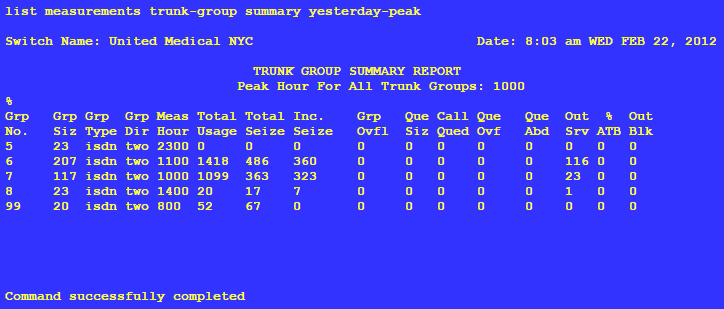Support: List Measurements Trunk-group Summary Yesterday-peak
This report gives traffic measurements for all trunk groups. By using this command, you can determine the trunk group total usage (in CCS), the total number of calls, trunk blockage, and other measurement data.
Once the total usage (CCS) has been determined, AlarmTraq converts the total usage to erlangs in order to determine the required number of trunks needed to maintain a P.01 grade of service for the busiest hour of the previous day for each trunk group.
Grp Grp Grp Grp Meas Total Total Inc. Grp
Que Call Que Que Out % Out
No. Siz Type Dir Hour Usage Seize Seize Ovfl Siz Qued Ovf Abd Srv ATB Blk
------------------------------------------------------------------------------
6 207 isdn two 1100 1418 486 360 0
0 0 0 0 116 0
0
Trunk Group No = 6
Group Name = LOCAL PRI
Group Type = isdn
Group Busy Hour = 1100
Working Trunks = 91
Total Usage(CCS) = 1418
Total Usage(Erlangs) = 39.3889
Blocking Probability (39.3889 Erlangs and 91 Trunks) = 0.0001
Trunks Required for P.010 Grade of Service = 52
The data is then stored in the SQL database for later reporting and analysis. PBX traffic load is generally measured in 100 call-second units known as Centum Call Seconds (CCS). Centum from Latin, signifies 100.
The maximum traffic load per trunk during the Busy Hour is equal to 36 CCS, which is a shorthand method of stating 3600 seconds. Thirty-six CCS is equivalent to 60 minutes, or 1 hour of traffic load.
Combining the trunk group traffic load with an acceptable GOS level results in the following traffic requirement: 6 CCS, P(0.01). This notation signifies that a station user with an expected 6 CSS traffic load is willing to accept a 1 percent probability of call blocking when attempting to use the switch network. A 2 percent blocking probability would be expressed as 6 CCS P(0.02); a 0.1 percent blocking probability would be expressed as 6 CCS P(0.001).

